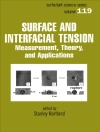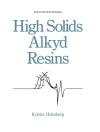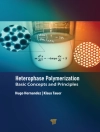>Supported Metal Single Atom Catalysis
Covers all key aspects of supported metal single atom catalysts, an invaluable resource for academic researchers and industry professionals alike
Single atom catalysis is one of the most innovative and dynamic research areas in catalysis science. Supported metal catalysts are used extensively across the chemical industry, ranging from fine and bulk chemical production to petrochemicals. Single atom catalysts (SACs) combine the advantages of both homogeneous and heterogeneous catalysts such as catalyst stability, activity, and high dispersion of the active phase.
Supported Metal Single Atom Catalysis provides an authoritative and up-to-date overview of the emerging field, covering the synthesis, preparation, characterization, modeling, and applications of SACs. This comprehensive volume introduces the basic principles of single atom catalysis, describes metal oxide and carbon support materials for SAC preparation, presents characterization techniques and theoretical calculations, and discusses SACs in areas including selective hydrogenation, oxidation reactions, activation of small molecules, C-C bond formation, and biomedical applications.
- Highlights the activity, selectivity, and stability advantages of supported metal SACs compared to other heterogeneous catalysts
- Covers applications of SACs in thermal catalysis, electrocatalysis, and photocatalysis
- Includes chapters on single atom alloys and supported double and triple metal atom catalysts
- Discusses the prospects, challenges, and potential industrial applications of SACs
Supported Metal Single Atom Catalysis is an indispensable reference for all those working in the fields of catalysis, solid-state chemistry, materials science, and spectroscopy, including catalytic chemists, organic chemists, electrochemists, theoretical chemists, and industrial chemists.
Daftar Isi
Foreword xv
Preface xxi
1 Introduction to Supported Metal Single Atom Catalysis 1
Doan Pham Minh and Philippe Serp
1.1 Introduction 1
1.2 Definition 4
1.3 Origins of Supported Metal Single Atom Catalysts 7
1.4 Challenges, Limitations, and Possible Opportunities in Supported Metal Single Atom Catalysis 14
1.4.1 Metal Loading in Supported Metal Single Atom Catalysts 14
1.4.2 Metallic Species Homogeneity in Supported Metal Single Atom Catalysts 17
1.4.2.1 Are Clusters or Nanoparticles Present in Supported Metal Single Atom Catalysts? 17
1.4.2.2 Control of the Local Environment of Single Atoms in Supported Metal Single Atom Catalysts 18
1.4.3 Metal Single Atom Stability and Dynamic in Supported Metal Single Atom Catalysts 21
1.4.3.1 Thermal and Chemical Stability 21
1.4.3.2 Supported Single Atom Dynamics in Chemical Reactions 26
1.4.4 Obtaining Reliable Information About the Active Sites of Metal SACs 30
Acknowledgments 31
References 31
2 Preparation of Supported Metal Single-Atom Catalysts on Metal Oxides and Hydroxides 51
Canio Scarfiello, Jeremy Audevard, Carole Le Berre, Katerina Soulantica, Philippe Serp, and Doan Pham Minh
2.1 Introduction 51
2.2 Gas-Phase Deposition Methods 52
2.2.1 Mass-Selected Soft-Landing Method 52
2.2.2 Atomic Layer Deposition (ALD) Method 53
2.3 Wet Chemistry Methods 58
2.3.1 Impregnation Methods 58
2.3.1.1 Wet Impregnation 58
2.3.1.2 Incipient Wetness Impregnation (IWI) 66
2.3.1.3 Strong Electrostatic Adsorption (SEA) 70
2.3.2 Co-precipitation Method 74
2.3.3 Deposition–Precipitation Method (DP) 77
2.3.4 SAC Synthesis via Ion Exchange 80
2.3.5 Sol–Gel Solvent Vaporization Self-Assembly Method 82
2.4 Photochemical Methods 83
2.5 Electro-chemical Methods 85
2.6 Top-Down Methods 87
2.7 Other Methods 90
2.8 Conclusions 92
Acknowledgments 93
References 93
3 Preparation of Supported Metal Single-Atom Catalysts on Carbon Supports 101
Camila Rivera-Cárcamo and Philippe Serp
3.1 Introduction 101
3.2 Atomic Layer Deposition (ALD) 102
3.3 Solution-Phase Syntheses 105
3.3.1 Impregnation 105
3.3.2 Low-Temperature Techniques 109
3.4 Sputtering 111
3.5 Top-Down Methods 114
3.6 Pyrolysis Methods 117
3.6.1 MOF-Derived SACs 118
3.6.2 Template Sacrificial Approach 121
3.6.3 Other Sources 124
3.7 Polymerization 127
3.8 Other Methods 130
3.9 Conclusion 133
Acknowledgments 135
References 135
4 Single-Metal Alloys 145
Jianyu Han, Junju Mu, and Feng Wang
4.1 Introduction 145
4.2 Diluted Single-Atom Alloy Catalysts 146
4.2.1 Synthesis of Diluted Single-Atom Alloy Catalysts 146
4.2.2 Characterizations of Diluted Single-Atom Alloy Catalysts 148
4.2.3 Catalytic Performances of Diluted Single-Atom Alloy Catalysts 149
4.3 Single-Atom Doping Alloy Catalysts 150
4.3.1 Synthesis of Single-Atom Doping Alloy Catalysts 150
4.3.2 Characterizations of Single-Atom Doping Catalysts 152
4.3.3 Catalytic Applications of Single-Atom Doping Alloys 153
4.4 Diatomic Alloy Catalysts 153
4.4.1 Synthesis of Diatomic Alloy Catalysts 153
4.4.2 Characterizations of Diatomic Alloy Catalysts 155
4.4.3 Catalytic Applications of Diatomic Alloys 156
4.5 Machine Learning-Guided Single-Atom Alloy Catalyst Design 157
4.6 Perspectives 159
References 161
5 Characterization of Supported Metal Single-Atom Catalysts 169
Lei Zhang, Kieran Doyle-Davis, and Xueliang Sun
5.1 Introduction 169
5.2 Morphology Characterization 170
5.2.1 Transmission Electron Microscopy (TEM) 170
5.2.1.1 Introduction of TEM 170
5.2.1.2 TEM Characterization Technique 171
5.2.1.3 Characterization of Typical SACs 171
5.2.2 Scanning Tunneling Microscopy (STM) 175
5.2.2.1 Introduction of STM 175
5.2.2.2 STM Characterization of SACs 176
5.3 Structure Characterization 177
5.3.1 Synchrotron Radiation X-ray 177
5.3.1.1 Fundamentals of Synchrotron Radiation X-ray 177
5.3.1.2 XANES 177
5.3.1.3 EXAFS 179
5.3.1.4 In situ XAS Study on Structural Evolution During Catalytic Reaction 182
5.3.2 Infrared (IR) Spectroscopy 183
5.3.3 Mössbauer Spectroscopy 186
5.3.4 X-ray Photoelectron Spectroscopy (XPS) 187
5.3.5 Solid-State Nuclear Magnetic Resonance 189
5.3.6 Electron Paramagnetic Resonance (EPR) 190
5.3.7 Photoluminescence 190
5.4 Loading Amount Characterization 191
5.4.1 Inductively Coupled Plasma Atomic Emission Spectrometry 191
5.4.2 Thermogravimetric Analysis 192
5.5 Summaries and Outlook 192
References 193
6 In situ/Operando Techniques for Characterization of Supported Metal Single-Atom Catalysts 199
Alberto Casu, Samy Ould-Chikh, Gavin Mountjoy, Anna Corrias, and Andrea Falqui
6.1 Introduction 199
6.2 In situ/Operando XAS 200
6.2.1 Method 200
6.2.2 X-ray Absorption Near-Edge Structure (XANES) 201
6.2.3 Extended X-ray Absorption Fine Structure (EXAFS) 202
6.2.4 In situ/Operando XAS of SACs Consisting of Transition Metals in Period 3 203
6.2.5 In situ/Operando XAS of SACs Consisting of Precious Metals in Period 4 205
6.2.6 In situ/Operando XAS of SACs Consisting of Platinum on Oxide Supports 206
6.2.7 In situ/Operando XAS of SACs Consisting of Platinum on Non-oxide Supports 208
6.2.8 In situ/Operando XAS of SACs Consisting of Precious Metals in Period 5 Other than Platinum 209
6.2.9 In situ/Operando XAS of Other Atoms in SACs and Further Studies 210
6.3 Other In situ/Operando Spectroscopies: IR, UV–vis and Mössbauer Spectroscopies, and XPS 210
6.3.1 Methods 210
6.3.2 In situ/Operando IR Spectroscopy of SACs Consisting of Platinum 212
6.3.3 In situ/Operando IR Spectroscopy of SACs Consisting of Metal Atoms Other than Platinum 215
6.3.4 In situ/Operando UV–vis and Mössbauer Spectroscopy, and XPS of SACs 216
6.4 In situ/Operando Electron Microscopy 218
6.4.1 State of the Art 218
6.4.2 In situ Imaging During the Synthesis of SACs 221
6.4.3 In situ Observation of Catalysis Reactions at Single Atoms in Motion 226
6.5 Summary and Conclusions 232
References 234
7 Contribution of Theoretical Calculations to Supported Metal Single-Atom Catalysis 241
Javier Navarro-Ruiz, Romuald Poteau, Iann C. Gerber, and Iker del Rosal
7.1 Introduction 241
7.2 Carbon-Based Support Models 242
7.2.1 Anchoring Sites on Carbon Materials 243
7.2.1.1 SAs-Fullerene 243
7.2.1.2 SAs-CNT 244
7.2.1.3 SAs-Graphene 245
7.2.2 Physicochemical Properties of the SAs upon Anchorage 248
7.2.2.1 Platinum 249
7.2.2.2 Palladium 250
7.2.2.3 Other TMs 251
7.3 Hydrogen Spillover 252
7.3.1 Hydrogen Adsorption and Dissociation on the Metal Catalyst 253
7.3.2 Hydrogen Migration from the Metal Catalyst to the Support 256
7.3.3 Hydrogen Diffusion on the Support 258
7.4 Mechanistic Studies on C-SACs 260
7.4.1 Thermocatalysis 261
7.4.1.1 C–H Activation 261
7.4.1.2 Hydrogenation 263
7.4.1.3 CO2 Hydrogenation 263
7.4.1.4 CO Oxidation 264
7.4.1.5 Other Reactions 266
7.4.2 Electrocatalysis 266
7.4.2.1 Water Splitting 266
7.4.2.2 Oxygen Reduction Reaction 269
7.4.2.3 Carbon Dioxide Reduction Reaction 271
7.4.2.4 Other Reactions 273
7.5 Oxide Support Models 273
7.5.1 Aluminum Oxide 274
7.5.2 Cobalt Oxides 279
7.5.3 Cerium Oxide 281
7.5.4 Magnesium Oxides 290
7.5.5 Titanium Dioxide 294
7.5.6 Zirconium Oxide 302
7.5.7 Zinc Oxide 306
7.6 Conclusions 307
Acknowledgements 307
References 307
8 Supported Metal Single Atom Thermocatalysts for Selective Hydrogenation 339
Eva Castillejos, Ana B. Dongil, Inmaculada Rodríguez-Ramos, and Antonio Guerrero-Ruiz
8.1 Introduction 339
8.2 Hydrogenation Reactions Catalyzed by Single-Atom Supported on Carbon Materials 342
8.2.1 Noble-Metal Single-Atom Catalysts 344
8.2.2 Non-Noble Metal Single-Atom Catalysts 348
8.3 Hydrogenation Reactions Catalyzed by SACs Supported on Unreducible Metal Oxides 352
8.4 Hydrogenation Reactions Catalyzed by SACs Supported on Reducible Metal Oxide Ce O2 and Ti O2 360
8.5 Hydrogenation Reactions Catalyzed by SACs Supported on Metallic Surfaces 367
8.6 Summary and Conclusions 369
Acknowledgments 370
References 371
9 Supported Metal Single-Atom Thermocatalysts for Oxidation Reactions 377
Laurent Piccolo, Stéphane Loridant, and Phillip Christopher
9.1 Introduction 377
9.2 Oxide-Supported Single-Atom Catalysts 378
9.2.1 CO Oxidation 379
9.2.1.1 PGM on Alumina 379
9.2.1.2 PGM on Iron Oxide 382
9.2.1.3 Noble Metals on Titania 383
9.2.1.4 Late Transition Metals on Ceria 386
9.2.1.5 Other Catalysts 390
9.2.1.6 Discussion 391
9.2.2 Preferential CO Oxidation in Hydrogen (PROX) 393
9.2.3 Water–Gas Shift Reaction (WGSR) 394
9.2.4 Total Oxidation of Hydrocarbons 397
9.2.5 Selective Oxidation Reactions 398
9.2.5.1 Early Transition Metals on Oxides 398
9.2.5.2 Late Transition Metals on Oxides 399
9.3 Single-Atom Catalysts Supported on Carbon and Other Materials 401
9.3.1 Carbon and Nitrogen-Hosted SAC 401
9.3.1.1 Selective Oxidation of Alcohols 402
9.3.1.2 Selective Oxidation of Hydrocarbons 402
9.3.1.3 Other Reactions 403
9.3.2 Single-Atom Alloy Catalysts 404
9.4 Summary and Conclusions 404
References 406
10 Supported Metal Single-Atom Thermocatalysts for the Activation of Small Molecules 425
Marcos G. Farpón, Wilson Henao, and Gonzalo Prieto
10.1 Introduction 425
10.2 Methane Conversion on Single-Atom Catalysts 426
10.2.1 Methane Activation: Mechanistic Considerations 428
10.2.2 Methane Conversion on Single-Atom Catalysts: State of the Art and Challenges Ahead 431
10.2.2.1 Oxidative Routes 431
10.2.2.2 Non-oxidative Routes 435
10.3 CO2 Conversion on Single-Atom Catalysts 439
10.3.1 CO2 Activation: Mechanistic Considerations 440
10.3.2 CO2 Hydrogenation on Single-Atom Catalysts: State of the Art, Advantages, and Limitations 442
10.4 CO Conversion on Single-Atom Catalysts 446
10.4.1 CO Activation: Fundamental Considerations 447
10.4.2 Water–Gas-Shift Reaction 449
10.4.3 CO Oxidation 451
10.4.4 Other CO Conversion Catalysis with SACs 455
10.5 Activation and Selective Conversion of Other Small Molecules with SACs 456
10.6 Concluding Remarks 459
Acronym 460
References 461
11 Supported Metal Single Atom Thermocatalysts for C—C, C—Si, and C—B Bond–Forming (Coupling) Reactions and Biomedical Applications 473
Rossella Greco, Marta Mon, and Antonio Leyva–Pérez
11.1 Introduction 473
11.1.1 Chronology of Single-Atom Catalysts 473
11.1.2 Use of SACs in Reactions of Interest for Organic Synthesis and Biomedical Applications 476
11.2 Carbon–Carbon Cross-Coupling Reactions 478
11.3 Hydrosilylation and Hydroboration Reactions 487
11.3.1 Hydrosilylation Reactions 487
11.3.2 Hydroboration Reactions 490
11.4 Biomedical Applications 492
11.5 Summary and Conclusions 495
References 496
12 Supported Metal Single-Atom Thermo-Catalysts for Reforming Reactions 503
Xuan-Huynh Pham and Doan Pham Minh
12.1 Introduction 503
12.2 Supported Metal Single Atoms for Methane Reforming 505
12.2.1 Noble-Metal Single-Atom Catalysts for Methane Reforming 506
12.2.2 Ni-Based Single-Atom Catalysts for Methane Reforming 511
12.2.3 Synergy Between Noble and Transition Metals in SACs 515
12.3 Supported Metal Single Atoms for Hydrocarbon Reforming 517
12.4 Supported Metal Single Atoms for Aqueous-Phase Reforming of Alcohols 522
12.5 Conclusions and Outlook 527
Acknowledgments 528
References 528
13 Electrocatalysis with Single-Metal Atom Sites in Doped Carbon Matrices 531
Tristan Asset, Frédéric Maillard, and Frédéric Jaouen
13.1 Introduction 531
13.2 Synthesis Methods 533
13.2.1 Hard Templating with Silica 537
13.2.2 Soft Templating with Metal–Organic Frameworks 537
13.2.3 Sacrificial Polymers 539
13.2.4 Electrospun Polymer/MOF Composites 540
13.2.5 Synthesis of Metal–N–C SACs Beyond Fe and Co 541
13.2.6 Synthesis of Metal–S–C SACs 542
13.3 Characterization Methods and Structure 542
13.3.1 Structure of metal SA Sites 542
13.3.1.1 Different Fe–Nx Cy Moieties 543
13.3.1.2 Macroscopic Structure 545
13.3.1.3 Importance of the Carbon Surface and π-Electron Delocalization 545
13.3.2 Characterization Methods Dedicated to Metal–N–C SACs 546
13.4 Applications in Electrocatalysis 550
13.4.1 Oxygen Reduction Reaction 550
13.4.2 CO2 Reduction, N2, and NO3 − Reduction 554
13.5 Stability of Metal–N–C Electrocatalysts 559
13.5.1 Demetallation in the Absence of Carbon Oxidation 559
13.5.2 Changes in the Chemical and Physical Nature of the Metal Ion: Metal–N–C as a Pre-catalyst 561
13.5.3 Protonation of Nitrogen Atoms 562
13.5.4 Carbon Oxidation Reaction 562
13.5.5 Effect of Hydrogen Peroxide 563
13.5.6 Migration and Aggregation of metal SAs 564
13.5.7 Combined Effects 565
13.6 Summary and Conclusions 565
References 567
14 Supported Metal Single-Atom Photocatalysis 583
Bruno F. Machado, Lifeng Liu, Zhipeng Yu, and Joaquim L. Faria
14.1 Introduction 583
14.2 Synthesis and Characterization Methods 585
14.2.1 Synthesis 585
14.2.2 Characterization 587
14.2.3 Effects of Single Atoms in Photocatalysis 587
14.3 SAC Performance in Photocatalysis 589
14.3.1 Photocatalytic Water Splitting 589
14.3.2 Photocatalytic CO2 Reduction 592
14.3.3 Photocatalytic Fixation of Nitrogen 594
14.3.4 Photocatalytic Production of H2O2 with Environmental Significance 594
14.3.5 Photocatalytic Organic Synthesis 595
14.4 SACs for Photoelectrocatalysis 596
14.4.1 Photoelectrocatalytic Hydrogen Evolution 597
14.4.2 Photoelectrocatalytic Oxygen Evolution 599
14.4.3 Photoelectrocatalytic Carbon Dioxide Reduction and Nitrogen Reduction 601
14.5 Summary and Outlook 603
Acknowledgments 604
References 605
15 Supported Double and Triple Metal Atom Catalysts 613
Zhiwen Chen, Chandra V. Singh, and Qing Jiang
15.1 Introduction 613
15.2 Synthesis Routes 615
15.2.1 High Metal Atom Loading 615
15.2.2 Further SAC Grafting 615
15.2.3 Preselected Precursors for Double or Triple Atom Active Centers 615
15.2.4 Preselected Supports for Supporting DACs or TACs 617
15.2.4.1 Metallic Supports 617
15.2.4.2 Oxide Supports 617
15.2.4.3 2D Material Supports 619
15.2.4.4 Highly Porous and Specific Supports 620
15.3 Characterization Techniques 621
15.4 Applications 624
15.4.1 Thermocatalysis 624
15.4.1.1 CO Oxidation 624
15.4.1.2 Ammonia Synthesis 625
15.4.1.3 CO2 Reduction Reaction 626
15.4.1.4 Other Chemical Reactions 627
15.4.2 Electrocatalysis 628
15.4.2.1 Hydrogen Evolution Reaction (HER) 628
15.4.2.2 Oxygen Evolution Reaction (OER) 628
15.4.2.3 Oxygen Reduction Reaction (ORR) 630
15.4.2.4 CO2 Reduction Reaction (CO2RR) 632
15.4.2.5 Nitrogen Reduction Reaction (NRR) 634
15.4.3 Photocatalysis 636
15.5 Current Challenges and Future Outlook 637
15.6 Summary and Conclusions 637
Acknowledgments 638
References 638
Index 645
Tentang Penulis
Philippe Serp is Professor of Inorganic Chemistry, Toulouse University, France. His research is focused on nanocatalysis and molecular approaches to understand heterogeneous catalysis. He is a recipient of the Catalysis Division Award and Industrial Chemistry Division Award of the French Chemical Society. He has authored more than 200 publications, 3 books, and 19 patents.
Doan Pham Minh is Associate Professor, IMT Mines Albi, France. Since 2020, he is Deputy Director of the RAPSODEE Research Center. He investigates the valorization of biomass, bio-wastes, and industrial co-products into energy carriers and useful materials, as well as refractory ceramics and functional materials applied in thermo-conversion processes, catalytic processes, and thermal energy storage. He has published 90 articles, 9 book chapters, and 3 patents.












